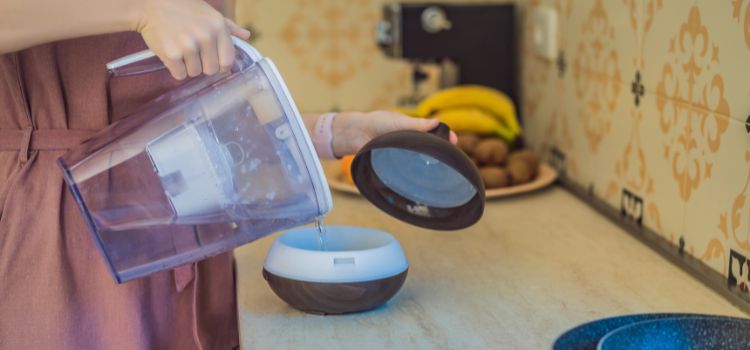As an Amazon Associate I earn from qualifying purchases.
Many homes now consider humidifiers to be necessary equipment since they relieve dry air and have many health advantages. But in order to maximize a humidifier’s efficiency and guarantee peak performance, you need to know how much water it consumes. We explore the variables affecting humidifier water use in this extensive overview, along with helpful advice for optimizing effectiveness.

Factors Influencing Water Consumption
Humidifier Type
The kind of humidifier you have greatly affects how much water it uses. The market offers a variety of varieties, such as impeller humidifiers, steam vaporizers, evaporative humidifiers, and ultrasonic humidifiers. Water usage varies according to each type’s unique mode of operation. For example, since evaporative humidifiers depend on a fan to force air through a wet wick or filter, they often require more water than ultrasonic types.
Humidifier Size and Capacity
A humidifier’s water consumption is directly influenced by its size and water capacity. Greater capacity humidifiers, which are larger, can store more water and hence operate longer before having to be refilled. They could, however, use more water overall, particularly if they are used often and at higher settings. To prevent using too much water, it’s important to take the size of the space you want to humidify into account and choose a humidifier with the right capacity.
Operating Settings
Water consumption is also affected by the humidifier’s operation parameters and humidity level. In order to keep the appropriate amount of moisture in the air, higher humidity levels force the humidifier to work harder and consume more water. On the other hand, smaller settings use less water. Furthermore, some humidifiers include mist outputs that may be adjusted or variable speed settings, giving consumers the flexibility to manage water use according to their requirements and preferences.
How Much Water Does a Humidifier Use?
Calculating water usage
It might be difficult to pinpoint how much water a humidifier really consumes since it relies on a number of factors. Nonetheless, by keeping an eye on the water level in the humidifier’s reservoir for a certain amount of time, a ballpark approximation may be determined.
Factors influencing water consumption
In addition to the previously listed variables, runtime, fan speed, and ambient conditions may also affect water use. A humidifier that is used on high settings for prolonged periods of time, for example, will use more water.
Tips for Maximizing Efficiency
Opt for Energy-Efficient Models
Choose energy-efficient humidifiers that have earned certification from respectable agencies like ENERGY STAR before making your purchase. With their ideal performance and reduced water and power use, these models will ultimately save you money on utility costs.
Regular Maintenance
Maintaining your humidifier properly will ensure maximum performance and increase its longevity. It is possible to avoid mineral accumulation and mold development in the humidifier, which may hinder its function and increase water usage, by routinely cleaning and sanitizing it and changing the filters and cartridges as directed by the manufacturer.
Use Distilled Water
Your humidifier’s lifetime may be increased and mineral accumulation reduced by using distilled water. Minerals and other contaminants found in tap water may build up over time in the humidifier, causing blockages and decreased effectiveness. Conversely, distilled water doesn’t contain any minerals, so it works at its best and requires less regular cleaning.
Monitor Humidity Levels
Use a hygrometer to periodically check the humidity levels in your house. This enables you to set your humidifier’s settings appropriately, avoiding over-humidification and needless water use. Aim for 30% to 50% relative humidity levels for maximum comfort and health advantages.
Proper Placement
The humidifier’s water consumption and efficiency might also be affected by where it is placed. To guarantee adequate ventilation and moisture dispersion, position the humidifier on a level, raised platform far from furnishings and walls. Keep it out of bright sunlight and close to heat sources to prevent water from evaporating too rapidly and using extra water.
Conclusion
It’s critical to comprehend how much water a humidifier utilizes in order to maximize effectiveness and guarantee peak performance. You may reduce water use while still reaping the advantages of a well-humidified atmosphere by taking into account variables like humidifier type, size and capacity, operation settings, and maintenance. To get the most out of your humidifier and create a cozy indoor environment for you and your family, pay attention to the advice provided in this article.
FAQs
Distilled or demineralized water is often advised in order to reduce mineral accumulation and stop white dust from evaporating into the atmosphere.
In order to avoid bacterial and mold development, you should clean your humidifier at least once a week. Specific cleaning procedures should be followed as directed by the manufacturer.
Essential oils work with certain humidifiers, but not all of them do. Prior to putting essential oils in your humidifier, follow the manufacturer’s instructions to prevent harm or failure.
Between 30% and 50% is usually the recommended humidity range for interior areas. Either high or low humidity-related problems may be avoided by keeping this range maintained.
It’s true that using a humidifier to improve air quality and reduce allergens like pollen and dust might help relieve allergy symptoms. Still, in order to prevent aggravated allergies, it’s essential to maintain a clean humidifier.
As an Amazon Associate I earn from qualifying purchases.








